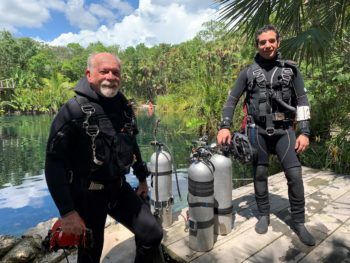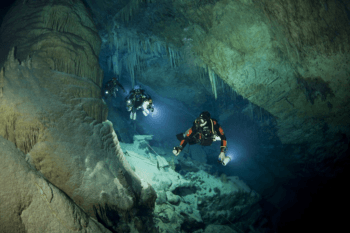Texas A&M Cave Diver Featured In New Netflix Series

Texas A&M University at Galveston Professor Thomas Iliffe is featured in Alien Worlds, a new Netflix series available now that examines what we know about biology and civilization on Earth to speculate how extraterrestrial life could evolve.
Iliffe’s cave diving segment in Episode 1 observes life in an underwater cave on the Yucatan Peninsula. The episode follows Iliffe, professor of marine biology at Texas A&M-Galveston, and his graduate student Fernando Calderon as they explore a cave that is believed to have been formed by a massive meteor that crashed into the area about 66 million years ago. The event changed climate conditions on Earth for decades, killing 75% of all life on the planet and leading to the eventual extinction of the dinosaurs.
The segment was filmed in the Yucatan Peninsula last fall prior to the COVID-19 pandemic.
“Our dives were filmed in a privately-owned cave called a ‘cenote’ that is not open to the public, but it has an exceptionally abundant fauna for reasons that are still not understood,” Iliffe said. “The entrance pool even has a crocodile. Once we jump in the water from a 10-foot-high ledge, there is no quick way to get out, but fortunately the crocodile tends to be more shy than it is aggressive.”
Iliffe said that cenotes from the northwestern corner of Mexico’s Yucatan Peninsula are laid out in a large, well-defined semicircle about 110 miles in diameter called the Ring of Cenotes. This ring marks the edge of the impact crater formed when a six-mile-wide meteor struck the area.
“In the film, I discuss how extraterrestrial events such as a meteor strike and the subsequent mass extinction shape life on a planet for many tens of millions of years to follow,” he said.

Iliffe has explored over 1,500 underwater caves, more than anyone else in the world. During his 40-year career, he has discovered more than 350 species of marine life.
Several years ago, he led a team of nine other divers who descended 462 feet into Phantom Springs Cave in West Texas, making it the deepest underwater cave dive ever in the United States. His work has drawn media attention from around the world and has been featured on The National Geographic Channel, The Discovery Channel and others.
For more information about Iliffe’s research, visit his website.
Media contacts:
- Tom Iliffe, 409-740-4454, iliffet@tamug.edu
- Rebecca Watts, Texas A&M-Galveston, 409-740-4840, rwatts@tamug.edu





